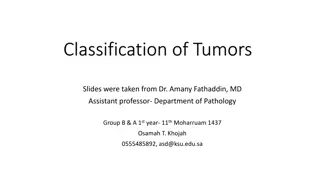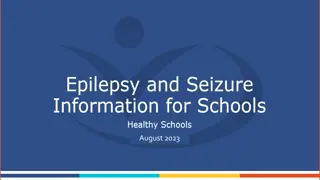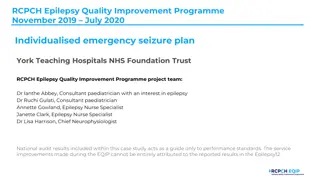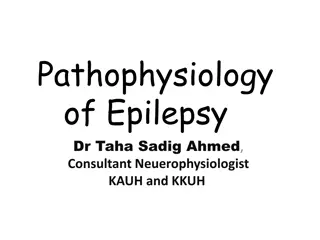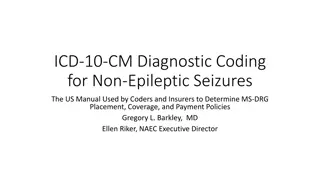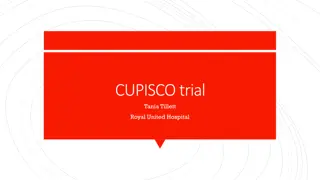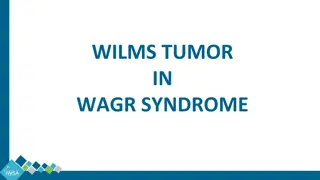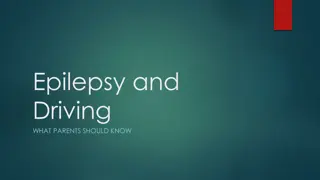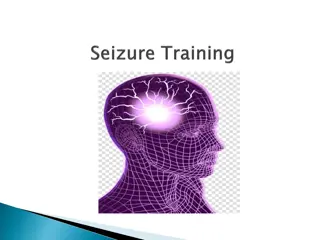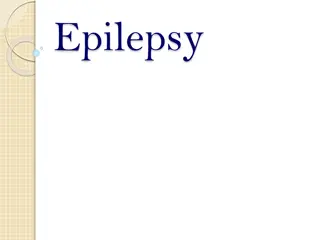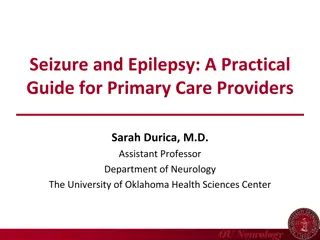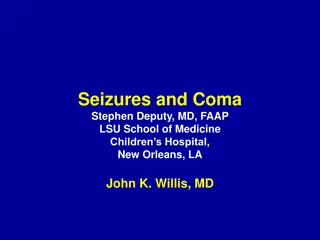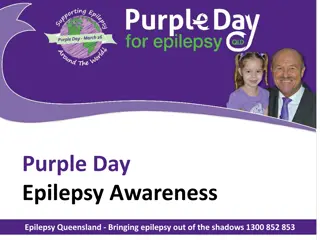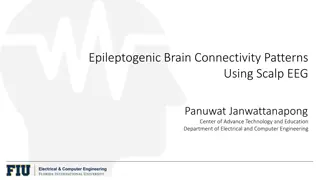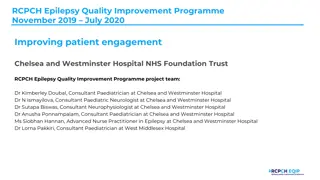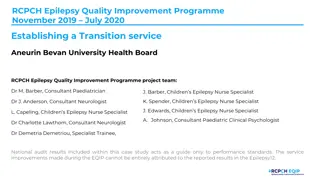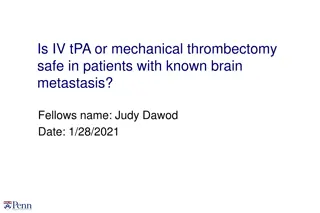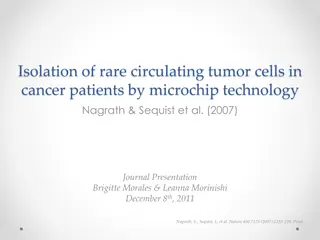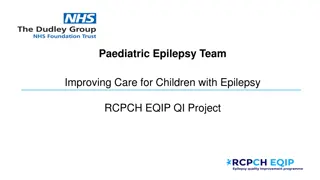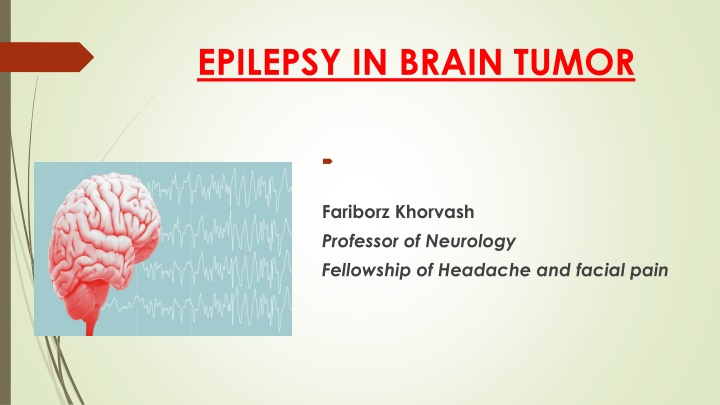
Epilepsy in Brain Tumor Patients: Understanding Seizure Risk Factors
Epileptic seizures are common in brain tumor patients, often being the first sign of a tumor. This article discusses the incidence, risk factors, and impact of epilepsy in brain tumor patients. Topics covered include histology, tumor location, and risk factors associated with brain metastases. Understanding these factors is crucial for effective diagnosis and management of brain tumor-related epilepsy.
Download Presentation

Please find below an Image/Link to download the presentation.
The content on the website is provided AS IS for your information and personal use only. It may not be sold, licensed, or shared on other websites without obtaining consent from the author. If you encounter any issues during the download, it is possible that the publisher has removed the file from their server.
You are allowed to download the files provided on this website for personal or commercial use, subject to the condition that they are used lawfully. All files are the property of their respective owners.
The content on the website is provided AS IS for your information and personal use only. It may not be sold, licensed, or shared on other websites without obtaining consent from the author.
E N D
Presentation Transcript
EPILEPSY IN BRAIN TUMOR Fariborz Khorvash Professor of Neurology Fellowship of Headache and facial pain
DEFINITION Epileptic seizures occur frequently in brain tumor patients and often represent the first clinical sign of a brain tumor and diagnosis of epilepsy is usually made after one seizure that meaning BRAIN TUMOR RELATED EPILEPSY(BTRE) BRAIN TUMOR RELATED EPILEPSY(BTRE)
Epileptic uncontrolled, have a negative effect on social and economic morbidity, health-related quality of life, and neurocognitive functioning in brain tumor patients Therefore, achieving control is one of the main treatment goals in brain tumor patients seizures, especially when participation, enduring seizure
incidence Primary brain tumors account for about 1.6% of all cancers Brain metastasis occur in about 25% of solid tumors About 25 60% of patients with intracranial tumor may develop symptoms of epilepsy In BTRE, seizures may occur either as an initial symptom that leads to the diagnosis of tumor (seen in about 30 50% of patients) or during the course of the disease (seen in 10 30% of patients)
Risk for epilepsy in brain tumor 1-histology The incidence of seizures is generally higher in patients with low-grade compared to high-grade brain tumors Up to 80%in low grade glioma 62-68% glioblastoma 40-47% meningioma 20%-25% brain metastasis
Risk for epilepsy in brain tumor 2-location of tumor Frontal, parietal and temporal localization of the brain tumor is reportedly associated with a higher risk of seizures compared to occipital localization
Risk for epilepsy in brain tumor In patients with brain metastases, > 4 metastases, high risk location of metastases (defined as frontal, parietal, temporal, or occipital cortex) and melanoma as the primary tumor are risk factors for the occurrence of BTRE
BRAIN METASTASIS The incidence of seizures in brain metastasis is lower , ranging from 24 to 34% Tumor type and location are the most important factors associated with the risk of seizures in brain metastases highest rate for seizures: 1-melanoma 2-lung cancer less frequent: ovarian/colorectal/prostate
BRAIN METASTASIS The risk is higher for patients with metastases involving or adjacent to brain regions with high epileptogenicity, such as motor cortex and temporal lobe Other risk factors are multiplicity of lesions, and headache or cognitive deficit at onset
pathophysiology (mechanism of epileptogenecity) Mechanical compression imbalance of vascularization and oxygen demand of the tumor, inflammatory processes neurotransmitter dysbalance
TREATMENT OF BTRE Antiepileptic drug Surgery Chemotherapy radiotherapy
ANTIEPILEPTIC DRUG criteria for the choice of ASM in patients with BTRE are: (1) mechanism of action & efficacy (2) dosage form (oral, intravenous) (3) avoidance of impairing side effects
About 60% of patients with brain tumors do not become seizure free with the first ASM and of those patients, only 40% eventually become seizure-free with a second line monotherapy or polytherapy
choice of AED Levetiracetam(FIRST LINE) LACOSAMIDE LAMOTRIGIN
LEVEBEL BENEFITS: can be applied intravenously fast titration is possible virtually no pharmacokinetic interaction SIDE EFFECT: neuropsychiatric side effects, particularly in patients with frontal tumors
LACOSAMIDE Intravenous application is available Titration is fast The rate of neuropsychiatric side effects is low There are very few interactions with other drugs Before initiation of LCM an atrioventricular block of second or higher degree has to be excluded via electrocardiogram
Management of recurrent seizures control of tumor growth(Particularly in high grade gliomas recurrent seizures can be a sign of progression ) control of seizure frequency: Prampanel Brivaracetam cenobamate
status epilepsy in brain tumor In adults, 7% of status epilepticus (SE) are due to brain tumors and SE in BTRE is associated with significant mortality At present, treatment recommendations for SE in BTRE are based on treatment recommendations for SE in all epilepsies
surgery Gross total resection is associated with a substantially better seizure outcome in glioma patients compared to nongross total resection which also applies to brain metastases and meningioma In glioblastoma, supra total surgical resection extends beyond the contrast-enhancing portion of the tumor and has been associated with improved overall survival and seizure control compared to gross total resection
chemotrapy Most commonly administered chemotherapy agents in glioma patients: - temozolomide, PCV (i.e. procarbazine, CCNU [lomustine], and vincristine - lomustine monotherapy
chemotherapy has been associated with an improved seizure outcome with seizure freedom rates ranging from 13% to 60% (administered PCV) and 13% to 50% (administered temozolomide) in low-grade glioma patients in elderly glioblastoma patients the beneficial effect of temozolomide on seizure outcome seems minimal
Radiotherapy A beneficial effect of radiotherapy on seizure outcome in brain metastases has not yet been established while it has been demonstrated in low-grade glioma patients with seizure freedom rates ranging from 20% after focal radiotherapy to 80% at 6 months after brachytherapy

